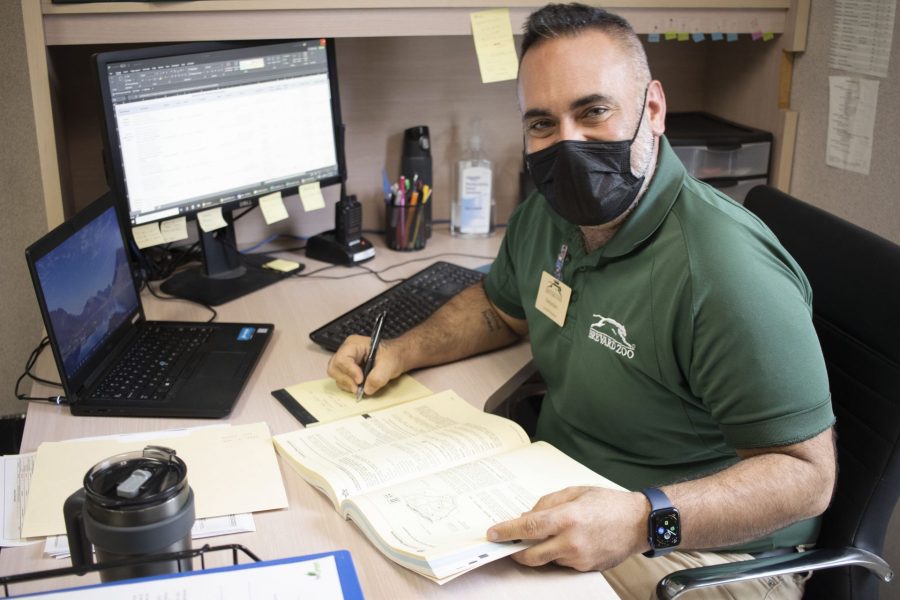

Animal registrar Sebastian Carcano ensures that every animal move into or out of Brevard Zoo goes smoothly.
You may have noticed quite a few new furry faces at our Zoo over the last month. From Bolivian gray titi monkeys to howler monkeys, we’ve been thrilled to welcome all our new residents.
These moves are carefully planned before our new residents even set foot on a plane or truck – sometimes months in advance. Our animal registrar Sebastian Carcano organizes every aspect of animal transfers, which can include everything from building or buying carriers to booking flights.
It’s a detailed process that’s unique to each and every animal coming to or leaving our Zoo. We’re lucky to have a dedicated staff member in charge of these important moves!
“It makes my OCD tingle,” Sebastian joked as he described his job. “You have to be incredibly organized to keep track of all the ins and outs.”
Why Do We Have to Say Goodbye – Or Hello?
Most transfers are made because they’ve been recommended by the Association of Zoos and Aquariums’ Species Survival Plan (SSP). SSPs are designed to manage the populations of animals within AZA-accredited zoos to ensure healthy, genetically diverse populations.

Wrinkled hornbills Morticia and Gomez sit together.
For example, wrinkled hornbills only live in pairs, making it important for mature chicks to find new homes. With the lineage within zoos in mind, SSP and studbook (pedigree) keepers can recommend a new home for the mature wrinkled hornbill that will hopefully result in his or her own chick someday. Once the facilities housing the potential match agree to the recommendation, staff from both facilities start the process of moving the individual.
“This way, the sending facility will be able to place the juvenile wrinkled hornbill, the receiving facility gets a mate for its single hornbill, and the captive population as a whole benefits from the genetic diversity of the wrinkled hornbills,” Sebastian said.
Folders of Information
Some moves can take place within a few days, while others can take over a year to plan – it all depends on the intensiveness of the paperwork and if their habitat is ready.
At our Zoo, the process starts with our Director of Animal Programs approving a move and determining the terms of the agreement. Sebastian then contacts the other facility to start the rest of the process.
Folders full of paperwork go into moving Zoo animals. The paperwork includes everything from the health certificate needed to verify that the animal is healthy to travel to a record from the animal’s original home describing their preferred diet and original habitat.
State and federal permits alone take up most of the folder. Class I and II animals, essentially species deemed to be dangerous to humans or the environment, need their own set of permits to be transported. Any nonnative species brought into Florida need an import permit. If the animal is being driven through different states, each state needs its own import permit.
Planning the actual mode of transport opens up a new set of questions – ground transport or a flight? If a flight, what airports and flight times make sense? What sort of secure carrier is needed?
Flights are used most often as they offer a quicker and more comfortable journey. Animals are loaded onto regular commercial passenger planes in a special temperature-controlled section of the cargo hold. This section of the plane is also used for personal pets.
“Most animal shipments are happening right underneath your feet!” Sebastian said.

The International Air Transport Association releases an annual manual outlining the appropriate carrier to use to transport every species.
Every year the International Air Transport Association publishes a manual that outlines – in detail – the type of carrier every species of animal needs to board a flight. Everything from space, ventilation, flooring and type of latches is specified.
The manual takes in account every animal’s needs and comfort. For example, flamingos need a small hammock in their carrier so they don’t spend the entire flight balanced on a foot.
Airlines don’t ship animals if the outside temperature is over 80 degrees or under 40 degrees. That temperature range is also required for any layovers.
“As you can imagine it is rarely under 80 in Florida, so our shipping season is mostly in the fall,” Sebastian said.
We strive to not only follow the federal and state regulations noted earlier in this story, but also the Association of Zoos and Aquarium standards for animal welfare.
“This can potentially be a stressful time for most animals so we do everything we can to make it easier on them,” Sebastian said. “Whether that means doing lots of crate training before the big shipment, providing them with the right crate and making the trip as short as possible.”
Welcome Home
In Florida, only a person with a permit from Florida Fish and Wildlife Conservation Commission is legally allowed to pick up or drop off animals – making Sebastian’s 10 years of experience as a zookeeper ideal. He can send off or pick up residents in comfort, setting them up with food, water and treats.
Moving an animal between zoos can be a lengthy detailed process, but we take on this challenge in the hopes it can lead to more comfortable lives for our animals and a more secure future for their species.
Brevard Zoo is an independent, not-for-profit organization that receives no recurring government funding for our operating costs. Your generous support enables us to continue to serve our community and continue our vital animal wellness, education and conservation programs.
